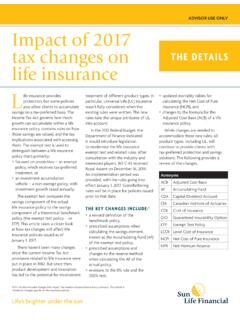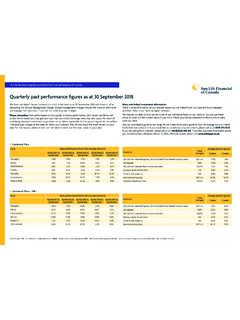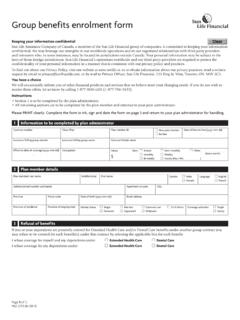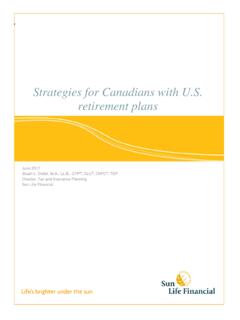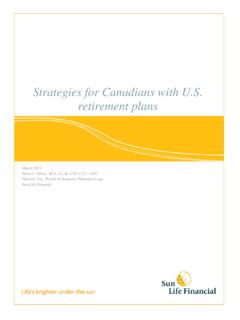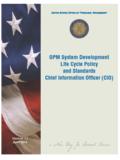Transcription of TAX IMPLICATIONS OF A LIFE INSURANCE POLICY TRANSFER
1 TAX IMPLICATIONS OF A life INSURANCE POLICY TRANSFER . life INSURANCE needs are not static. They evolve over time as family and financial situations change. This is true both for individuals and for the corporations they own. In the case of a life INSURANCE POLICY TRANSFER , questions often arise as to the tax repercussions of the transaction. What constitutes a disposition? Who is liable for the tax due, if any? Under what circumstances is a tax-free rollover available? What are the tax IMPLICATIONS of a TRANSFER between a business corporation and a shareholder or employee?
2 1. In certain situations, the TRANSFER of the interest in an existing POLICY to a new owner may be one solution to consider. Whether during the policyholder's lifetime or at death, or as part of a transaction involving corporations, the tax IMPLICATIONS of a TRANSFER of interest are sometimes difficult to assess. The TRANSFER of the ownership of a life INSURANCE POLICY raises both legal and tax concerns. These are questions that often arise in a financial planning context, and the answers, of course, will vary depending on the parties involved in the transaction. Whether or not they are dealing at arm's length can also affect the outcome of the process.
3 This bulletin will address some of these issues and will include some concrete examples to help illustrate the tax IMPLICATIONS of life INSURANCE POLICY transfers.. TRANSFER OF A life INSURANCE POLICY . The owner of the POLICY may choose to TRANSFER his interest in a life INSURANCE POLICY to another individual. In Quebec, civil law allows the assignment of an INSURANCE contract to a third party provided the assignee has an insurable interest in the life or health of the insured. If an insurable interest does not exist at the time of the transaction, the life insured must consent to the assignment in writing.
4 1. GENERAL RULES FOR life INSURANCE POLICY TRANSFERS. A life INSURANCE POLICY TRANSFER is a disposition within the meaning of subsection 148(9) of the Income Tax Act (ITA). Subsection 148(1) sets out the general rules that apply to the computation of tax in respect of a disposition. A life INSURANCE POLICY TRANSFER may trigger a POLICY gain, which is taxable in the hands of the transferor. The POLICY gain is equal to the proceeds of disposition minus the adjusted cost basis (ACB) of the interest in the life INSURANCE POLICY . This gain is fully taxable as ordinary income.
5 It should be noted that life INSURANCE policies do not fall into the tax category of capital property, so a taxpayer who disposes of his interest in a life INSURANCE POLICY does not realize a 1. Article 2418 of the Civil Code of Quebec. 2. capital gain; instead, it is a POLICY gain and he will not be able to claim any losses and the entire gain is taken into income. SPECIFIC RULES AND life INSURANCE POLICY TRANSFERS. Subsection 148(7) ITA contains specific rules that override the general rules discussed above. These rules apply when an interest in a life INSURANCE POLICY is disposed of by: distribution from a corporation.
6 Gift, either while living or by will;. TRANSFER by operation of law only; and TRANSFER in any manner to any person with whom the transferor is not dealing at arm's length. The notion of persons not dealing at arm's length is broader than the notion of related persons. Generally, the idea of not at arm's length refers to persons who are connected by blood relationship or marriage, as common-law partners or same-sex partners, or by adoption. Such a relationship may also exist between an individual and a corporation, a trust, or two corporations. 2. As an example, a corporation and a person who controls the corporation, or a person who is a member of a related group that controls the corporation, are related and are deemed not to deal with each other at arm's length.
7 Similarly, two corporations controlled by the same person or group of persons are deemed not to deal with each other at arm's length. Note that if a shareholder does not control a corporation and does not pay the fair market value (FMV) for the POLICY , the TRANSFER may be deemed to be a non-arm's length transaction or a distribution, which would be subject to the application of subsection 148(7). For transfers taking place after March 21, 2016 in a non-arm's length context, subsection 148(7) ITA. states that the proceeds of disposition to the transferor and the new ACB to the transferee will be equal to the highest of the following amounts the value of the interest in the POLICY at the time of the disposition.
8 2. Subsections 251(1) and 251(2) ITA; sections 18 and of the Taxation Act (TA). 3. the FMV of any consideration given for the interest in the POLICY ; and the ACB to the policyholder of the interest in the POLICY immediately prior to disposition. Value is defined in subsection 148(9) ITA as the amount the policyholder would be entitled to receive if the POLICY were surrendered, which is essentially the cash surrender value of the POLICY minus any unpaid POLICY loans. Lastly, subsection 148(7) ITA does not require that the FMV of the life INSURANCE POLICY be paid at the time of TRANSFER .
9 A disposition looks instead at the FMV of the consideration paid to acquire the POLICY when it is transferred. However, the FMV of the POLICY will have to be taken into consideration for the purpose of benefits under subsection 15(1) ITA, for example, or for valuation of a dividend payable in kind. ADJUSTED COST BASIS OF A life INSURANCE POLICY . The concept of adjusted cost basis (ACB) is defined in the Income Tax Act. 3 The adjusted cost basis represents the cost of the interest the policyholder has acquired in a life INSURANCE POLICY . This is the base value from which POLICY gains will be calculated.
10 The ACB of a policyholder's interest in a life INSURANCE POLICY is calculated according to a complex formula set out in the definition of adjusted cost basis in subsection 148(9) ITA. This amount may vary depending on the acquisition date of the POLICY , the nature of the POLICY (which could be a life INSURANCE POLICY or an annuity), and any transactions that have taken place on the POLICY , such as POLICY loans or the payment of dividends. It is increased by certain factors, such as the amount of premiums paid, and it is reduced by others, such as the net cost of pure INSURANCE (NCPI).
